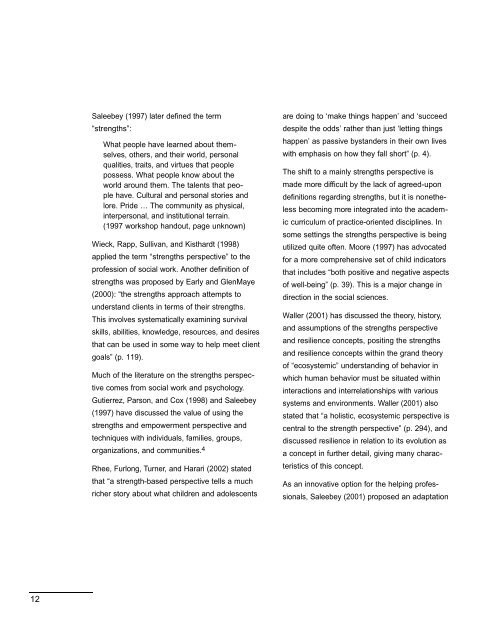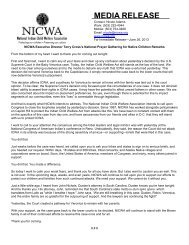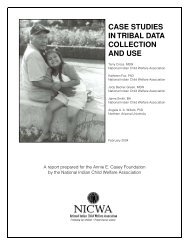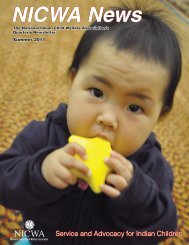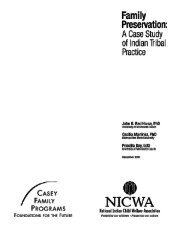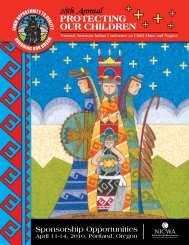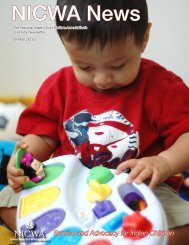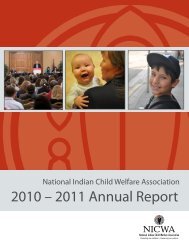Native American Children and Youth Well-Being Indicators
Native American Children and Youth Well-Being Indicators
Native American Children and Youth Well-Being Indicators
You also want an ePaper? Increase the reach of your titles
YUMPU automatically turns print PDFs into web optimized ePapers that Google loves.
Saleebey (1997) later defined the term“strengths”:What people have learned about themselves,others, <strong>and</strong> their world, personalqualities, traits, <strong>and</strong> virtues that peoplepossess. What people know about theworld around them. The talents that peoplehave. Cultural <strong>and</strong> personal stories <strong>and</strong>lore. Pride … The community as physical,interpersonal, <strong>and</strong> institutional terrain.(1997 workshop h<strong>and</strong>out, page unknown)Wieck, Rapp, Sullivan, <strong>and</strong> Kisthardt (1998)applied the term “strengths perspective” to theprofession of social work. Another definition ofstrengths was proposed by Early <strong>and</strong> GlenMaye(2000): “the strengths approach attempts tounderst<strong>and</strong> clients in terms of their strengths.This involves systematically examining survivalskills, abilities, knowledge, resources, <strong>and</strong> desiresthat can be used in some way to help meet clientgoals” (p. 119).Much of the literature on the strengths perspectivecomes from social work <strong>and</strong> psychology.Gutierrez, Parson, <strong>and</strong> Cox (1998) <strong>and</strong> Saleebey(1997) have discussed the value of using thestrengths <strong>and</strong> empowerment perspective <strong>and</strong>techniques with individuals, families, groups,organizations, <strong>and</strong> communities. 4Rhee, Furlong, Turner, <strong>and</strong> Harari (2002) statedthat “a strength-based perspective tells a muchricher story about what children <strong>and</strong> adolescentsare doing to ‘make things happen’ <strong>and</strong> ‘succeeddespite the odds’ rather than just ‘letting thingshappen’ as passive byst<strong>and</strong>ers in their own liveswith emphasis on how they fall short” (p. 4).The shift to a mainly strengths perspective ismade more difficult by the lack of agreed-upondefinitions regarding strengths, but it is nonethelessbecoming more integrated into the academiccurriculum of practice-oriented disciplines. Insome settings the strengths perspective is beingutilized quite often. Moore (1997) has advocatedfor a more comprehensive set of child indicatorsthat includes “both positive <strong>and</strong> negative aspectsof well-being” (p. 39). This is a major change indirection in the social sciences.Waller (2001) has discussed the theory, history,<strong>and</strong> assumptions of the strengths perspective<strong>and</strong> resilience concepts, positing the strengths<strong>and</strong> resilience concepts within the gr<strong>and</strong> theoryof “ecosystemic” underst<strong>and</strong>ing of behavior inwhich human behavior must be situated withininteractions <strong>and</strong> interrelationships with varioussystems <strong>and</strong> environments. Waller (2001) alsostated that “a holistic, ecosystemic perspective iscentral to the strength perspective” (p. 294), <strong>and</strong>discussed resilience in relation to its evolution asa concept in further detail, giving many characteristicsof this concept.As an innovative option for the helping professionals,Saleebey (2001) proposed an adaptation12


